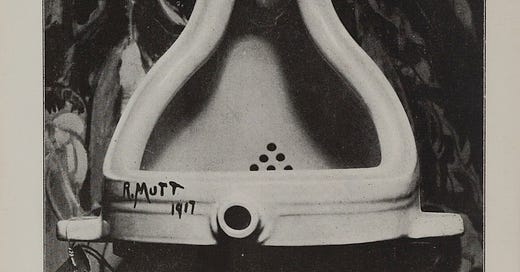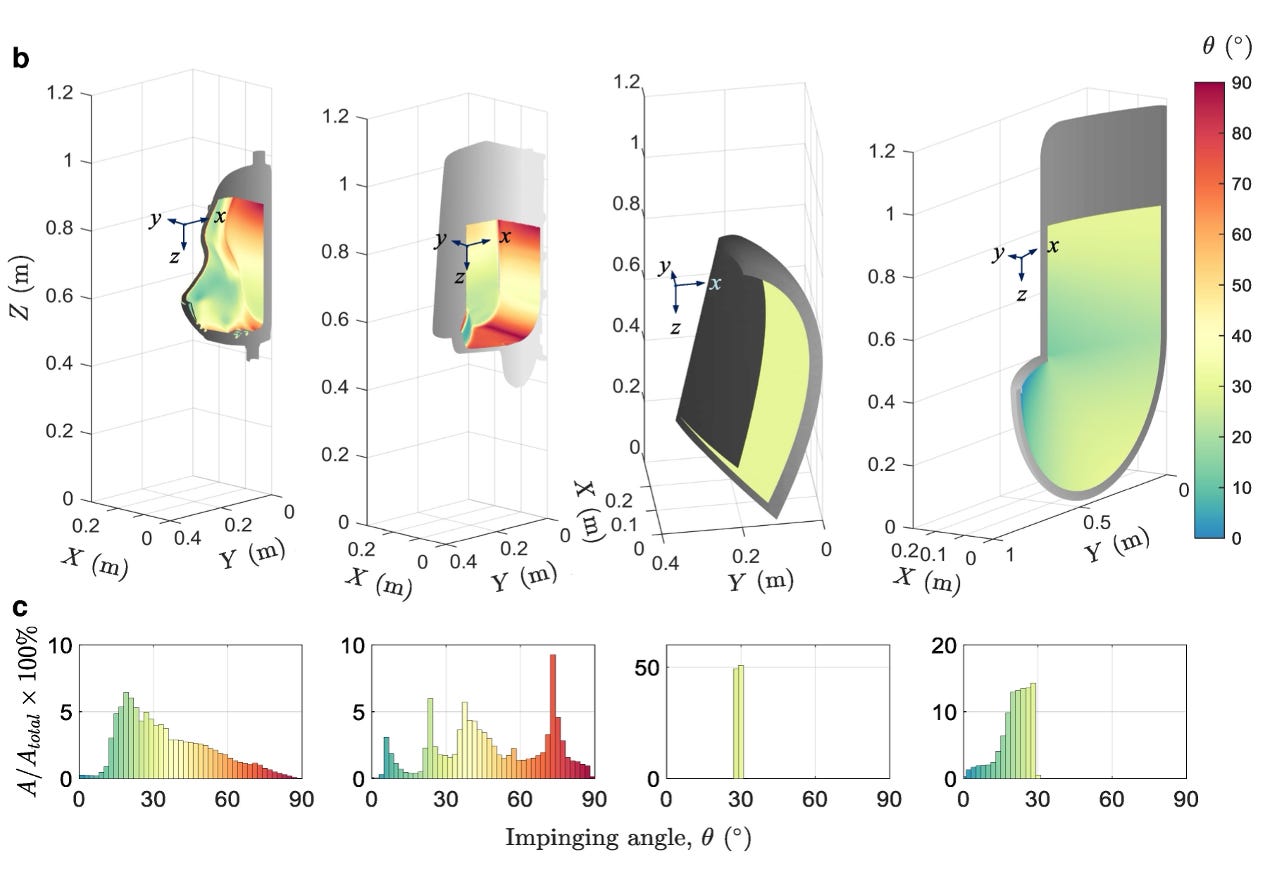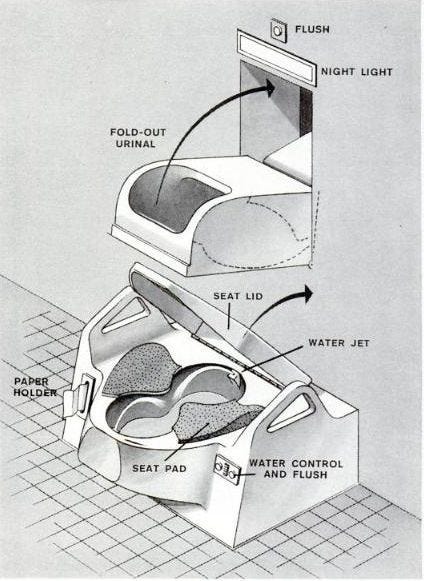Urine for a surprise: a splashless urinal
A new angle to an old problem, solved by nothing more than science and good design.
Longtime readers will know that I have been complaining about bathrooms since I started writing. We have killer bathtubs, stupid showers, silly sinks, and everything is getting worse, not better. I have not talked much about urinals, which have also got worse since Marcel Duchamp scrawled “R. Mutt” on the side of one in 1917.
Urinals used to often be floor-mounted and huge, but wall-mounted ones are much cheaper. These seem to be getting smaller; I am short and often use the lower kiddie one because the grown-up one is too high.
The problem is that in most public washrooms, the floor under and in front of the urinals is disgusting. It’s not that men are slobs (although many are); it’s bad design. There is the dreaded splashback, where pee bounces right back at you or onto the floor. And while the urinals are getting smaller, we have an ageing population of men with prostates that are getting larger, so urine streams are getting weaker, leading to even more of a mess.
However, help may be on the way, according to “Splash-free urinals for global sustainability and accessibility: Design through physics and differential equations.” It’s a new paper based on the work of Dr. Zhao Pan and his students* at the University of Waterloo. Pan told The New Scientist in 2022:
“The idea originated exactly where you think it did. “I think most of us have been a little inattentive at our post and looked down to find we were wearing speckled pants. Nobody likes having pee everywhere, so why not just create a urinal where splatter is extremely unlikely?”
The key to the design is the angle at which the urine stream hits the urinal; if it is less than 30 degrees, then splashback is almost completely eliminated. According to an earlier press release from the University of Waterloo, “Inspiration for the new urinal design came from the way dogs lift their hind legs to urinate against trees, a behaviour that instinctively minimizes the impact angle, and the curving structure of nautilus shells.” They compared the Duchamp classic La Fontaine, the usual contemporary one, and two new no-splash designs.
“Both Duchamp’s “La Fontaine” and a contemporary commercial design are not universally poor, but have areas where impinging streams have high angles, and thus high splashback. The novel designs, Cornucopia and Nautilus, have impinging angles at or below 30°.”

The Cornucopia design is the most effective, but it has a problem I am familiar with.
“Both novel urinal designs achieve significant splash reduction, with splash mass data, splash patterns, and impinging angle renders, all showing consistently low splash across multiple urination conditions. The Nautilus design comes out as the ideal choice due to the following factors. First, common urinals are subject to an installation dilemma. If installed at a typical height, it is not accessible to those with a short stature including children; while if installed at a lower height to address accessibility, it becomes uncomfortable for most people (adults) and generates greater splash due to larger drop distance and thus higher impact speed.”
In a rational world, these would be adopted everywhere; the study authors note that this is all about good design based on science, experimentation and engineering, not fashion and style.
“The superior performance of our design is achieved solely by manipulating the geometry of the urinal and does not require incorporating expensive or complicated surface materials or coatings; thus, the design is compatible with conventional materials and immediately suitable for mass implementation.”
It would save water and money; they calculate that a million litres of pee are spilled in the USA every day, and 10 million litres of water are used to clean it up. And, “In addition to cost savings, operators benefit from greater client, employee, and customer satisfaction from a clean and healthy environment. Those who do not use urinals, and as gender neutral washrooms proliferate, also benefit from cleaner bathroom space.”
I have often suggested that urinals should be installed in all of our bathrooms; it could save vast amounts of water and address the issue that men often miss, they don’t lift the seat, they drip, and they piss off the women who do most of the cleaning up. One study found that even when men hit the toilet, there is invisible splashback. “Every time a man pees into a toilet bowl while standing, thousands of droplets, most of which are small and can’t be easily spotted, bounce and fly around the bowl onto the underside of the seat (if it’s up) and even further afield.”
But even when companies develop good-looking residential designs, they suffer from all of the problems of traditional urinals, and there would likely still be a mess.
Back in the 1960s when Alexander Kira redesigned the toilet around how our bodies work, he realized that a urinal would be necessary. Now that Dr. Pan and his team have solved the problem of the urinal, perhaps they can solve the toilet, and we can all finally have bathroom fixtures that are designed for people, not plumbing.
*The full team: Kaveeshan Thurairajah , Xianyu (Mabel) Song , J D Zhu , Mia Shi , Ethan A Barlow , Randy C Hurd , Zhao Pan.
More potty posts:
How careless design of showers is killing, maiming, and scalding people of all ages. The standard tub/shower combination is lousy at either function and should be put out of its misery.
At the Interior Design Show: the latest in killer bathtubs and silly sinks- My wife asks, "Are you going to keep flogging this? Enough already!" But every year it just gets worse.
We hate our bathroom sink- The New Manual of the Dwelling looks at some basic plumbing.
Why the "bathroom of the future" always fails us- In a world full of incredible technology and ingenuity, why are we stuck in bathrooms from a hundred years ago?
Special offer!
I do not want to put up a paywall on this site, but it provides a meaningful portion of my income. So here’s a limited-time offer: I will send a signed copy of the print edition of “Living the 1.5 Lifestyle” to anyone in the USA or Canada who signs up for a one-year subscription (C$50, cheap at about US$35 ).










I remember the experiments that added an engraved “fly” to the urinal basin in the expectation that it would inspire greater accuracy among competitive male users of the urinals. But I also remember from my pub crawling days establishments that turned an entire wall into one long urinal lined by sheet metal or tiles- the trick was not accidentally stepping into the small trench at the bottom.
What I really absolutely hate are the “single axis” shower control handles, where you turn it one direction to turn it on, which gets you onto an ill-defined temperature range.
I want one axis for the flow, and a SEPARATE one for the temp, dammit!